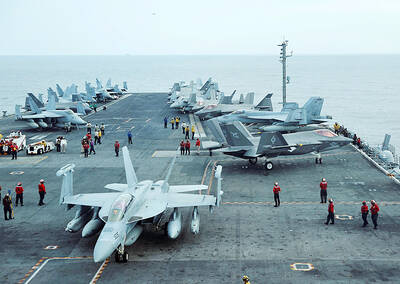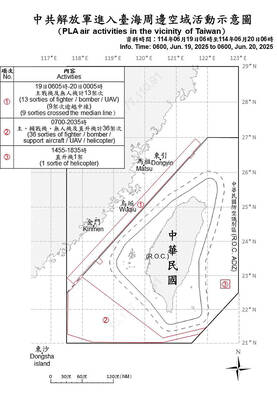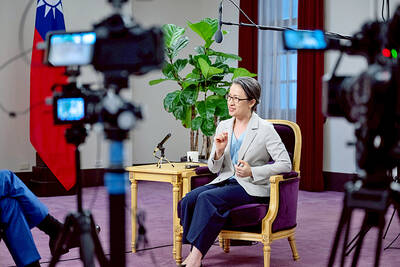The military plans to expand its weapons exports to foreign countries, especially those in the Middle East. This effort will be led by the newly established armament system, defense officials said yesterday.
The Combined Logistics Command (CLC) and the Chun Shan Institute of Science and Technology (CSIST) are to be the main providers of weapons available for sales to foreign countries.
The military is to target countries in the Middle East as the primary buyers of its weapons systems ranging from rifles and various types of ammunition to rockets and missiles.
The CSIST, for instance, has demonstrated its newly developed RT-2000 multiple rocket system at the 2003 Abu Dhabi International Defense Exhibition held in mid-March in the United Arab Emirates.
The RT-2000, already on order by the army, might become the first large weapon system exported to a foreign country in recent memory. But it will face stiff competition from similar products from other countries.
The biennial Abu Dhabi International Defense Exhibition has been chosen as the best platform to promote weapon systems to potential customers, defense officials said, adding that Taiwan exhibited its weapons there for the first time in 2001.
The CLC, formerly known as the combined services force, has been selling small arms to certain Middle Eastern countries for years but refused to admitted it.
A type of rifle developed by the CLC is currently used by a Middle Eastern country which has close military ties with Taiwan.
The CLC is desperate to sell a variety of conventional weapons it has developed. These weapons are mostly in storage due to the lack of large orders from the armed services.
Large-quantity sales of the Type-86 rifle, the latest variant of which is called the Type-91, has been slow because the armed services do not have any plans or the budget to buy it to replace their older rifles.
The last-generation Type-65K2 rifle, also developed by the CLC, is still the weapon most widely used by the armed services despite many complaints.
It has also been adopted by special operations units as their primary small arm, although its barrel is too long to allow a special-ops soldier to move freely in difficult terrain.
The armed services cannot keep up with the speed in which the CLC develops new products, mainly because of budgetary restraints.
To solve the problem of unused new weapon systems being stockpiled in warehouses, the military's newly established armament system decided to export the extra items.
The armament system, headed by deputy defense minister for armament General Chen Chao-ming (
It is to incorporate the CSIST and major production units of the CLC on Oct. 1. The CSIST is to become its research arm while the CLC's production units will provide it with the ability to produce weapons according to its own plans.
One of the missions of the armament system will be the promotion and sale of weapon systems to foreign countries, but it still has a long way to go to reach this goal.

China might accelerate its strategic actions toward Taiwan, the South China Sea and across the first island chain, after the US officially entered a military conflict with Iran, as Beijing would perceive Washington as incapable of fighting a two-front war, a military expert said yesterday. The US’ ongoing conflict with Iran is not merely an act of retaliation or a “delaying tactic,” but a strategic military campaign aimed at dismantling Tehran’s nuclear capabilities and reshaping the regional order in the Middle East, said National Defense University distinguished adjunct lecturer Holmes Liao (廖宏祥), former McDonnell Douglas Aerospace representative in Taiwan. If

TO BE APPEALED: The environment ministry said coal reduction goals had to be reached within two months, which was against the principle of legitimate expectation The Taipei High Administrative Court on Thursday ruled in favor of the Taichung Environmental Protection Bureau in its administrative litigation against the Ministry of Environment for the rescission of a NT$18 million fine (US$609,570) imposed by the bureau on the Taichung Power Plant in 2019 for alleged excess coal power generation. The bureau in November 2019 revised what it said was a “slip of the pen” in the text of the operating permit granted to the plant — which is run by Taiwan Power Co (Taipower) — in October 2017. The permit originally read: “reduce coal use by 40 percent from Jan.

‘SPEY’ REACTION: Beijing said its Eastern Theater Command ‘organized troops to monitor and guard the entire process’ of a Taiwan Strait transit China sent 74 warplanes toward Taiwan between late Thursday and early yesterday, 61 of which crossed the median line in the Taiwan Strait. It was not clear why so many planes were scrambled, said the Ministry of National Defense, which tabulated the flights. The aircraft were sent in two separate tranches, the ministry said. The Ministry of Foreign Affairs on Thursday “confirmed and welcomed” a transit by the British Royal Navy’s HMS Spey, a River-class offshore patrol vessel, through the Taiwan Strait a day earlier. The ship’s transit “once again [reaffirmed the Strait’s] status as international waters,” the foreign ministry said. “Such transits by

Taiwan is doing everything it can to prevent a military conflict with China, including building up asymmetric defense capabilities and fortifying public resilience, Vice President Hsiao Bi-khim (蕭美琴) said in a recent interview. “Everything we are doing is to prevent a conflict from happening, whether it is 2027 or before that or beyond that,” Hsiao told American podcaster Shawn Ryan of the Shawn Ryan Show. She was referring to a timeline cited by several US military and intelligence officials, who said Chinese President Xi Jinping (習近平) had instructed the Chinese People’s Liberation Army to be ready to take military action against Taiwan